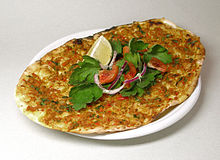
Back لحم بعجين Arabic لحم بعجين ARZ Lahmacun Azerbaijani Лахмаджун Bulgarian লাহমাজুন Bengali/Bangla Lahmacun Catalan لەحم بەعجیین CKB Lahmacun Czech Lahmacun German Qiymalıci DIQ
 Lahmacun with salad | |
| Alternative names | Lahmajun, lahmajoun, lahm b'ajin, lahmajo, lahmajin, lahamagine, lahmatzoun |
|---|---|
| Course | Main |
| Region or state | Levant[1] |
| Serving temperature | Warm |
| Main ingredients | Minced meat, vegetables and herbs |
| Part of a series on |
| İçli pide |
|---|
 |

Lahmacun (/ˌlɑːməˈdʒuːn/ lah-mə-JOON),[a] Lahmajun, or Lahmajo (Armenian: լահմաջո),[2] is a Middle Eastern flatbread topped with minced meat (most commonly beef or lamb), minced vegetables, and herbs including onions, garlic, tomatoes, red peppers, and parsley, flavored with spices such as chili pepper and paprika, then baked.[3] Lahmacun is often wrapped around vegetables, including pickles, tomatoes, peppers, onions, lettuce, parsley, and roasted eggplant.[4][5][6][7]
Originating from the Levant,[1] lahm bi ajeen or lahmacun is a popular dish in Lebanon and Syria.[8][9] In the Levant it is part of a series of foods called, collectively, Manakish - flatbreads with toppings. It is also sometimes referred to as "Lebanese pizza".[10] It is also very popular in Armenia[11][2] and Turkey.[11] It is sometimes described as "Armenian pizza",[12] or "Turkish pizza",[13] or similar names due to its shape and superficial similarity. However, unlike pizza, lahmacun is not usually prepared with cheese[11] and the crust is thinner.[14] In Lebanon, Syria, and Palestine it is also known as "sfiha" (Arabic: صفيحة, romanized: ṣafīḥa, lit. 'thin plate' or 'sheet').
- ^ a b Bartu, Ayfer (2001). "Rethinking Heritage Politics in a Global Context". In AlSayyad, Nezar (ed.). Hybrid Urbanism: On the Identity Discourse and the Built Environment. Greenwood Publishing Group. p. 154. ISBN 978-0-275-96612-6.
- ^ a b Cite error: The named reference
pwwas invoked but never defined (see the help page). - ^ Alkan, Sena (19 November 2016). "A delicious, fresh experience: try lahmacun". Daily Sabah. Retrieved 16 January 2020.
The true origin of lahmacun is a mystery...
- ^ Ghillie Basan (1997). Classic Turkish Cookery. Tauris Parke Books. p. 95. ISBN 1-86064-011-7.
- ^ Allen Webb (2012). Teaching the Literature of Today's Middle East. Routledge. pp. 70–. ISBN 978-1-136-83714-2.
- ^ Sally Butcher (2012). Veggiestan: A Vegetable Lover's Tour of the Middle East. Anova Books. pp. 128–. ISBN 978-1-909108-22-6.[permanent dead link]
- ^ Jeff Hertzberg, M.D.; Zoë François (2011). Artisan Pizza and Flatbread in Five Minutes a Day. St. Martin's Press. pp. 216–218. ISBN 978-1-4299-9050-9.
- ^ Cite error: The named reference
Marks1999was invoked but never defined (see the help page). - ^ Dmitriev, Kirill; Hauser, Julia; Orfali, Bilal (2019-09-24). Insatiable Appetite: Food as Cultural Signifier in the Middle East and Beyond. Brill. ISBN 978-90-04-40955-2.
- ^ Amari, Suad (2003-01-01). Cooking the Lebanese Way. Lerner Publications. p. 46. ISBN 978-0-8225-4116-5.
- ^ a b c Carol Helstosky (2008). Pizza: A Global History. London: Reaktion Books. pp. 59–. ISBN 978-1-86189-630-8.
- ^ "'Armenian Pizza' Is the Comfort Food You Didn't Know You Were Missing (Recipe)". Smithsonian Magazine. Retrieved 16 January 2020.
No one knows for certain whether lahmacun's roots lie in Armenia, or elsewhere in the Middle East. "The race to find where these ancient foods originated is not fruitful territory," cautioned Naomi Duguid, author of Taste of Persia: A Cook's Travels Through Armenia, Azerbaijan, Georgia, Iran, and Kurdistan. After all, meat-enhanced flatbreads are ubiquitous throughout the region...
- ^ "Turkish flatbread lahmacun – just don't call it pizza". South China Morning Post. 4 April 2015.
- ^ The Routledge Handbook of Mobilities. Routledge. 10 January 2014. ISBN 978-1-317-93412-7. Retrieved 16 January 2020.
Cite error: There are <ref group=lower-alpha> tags or {{efn}} templates on this page, but the references will not show without a {{reflist|group=lower-alpha}} template or {{notelist}} template (see the help page).